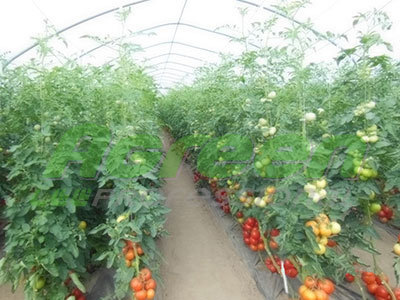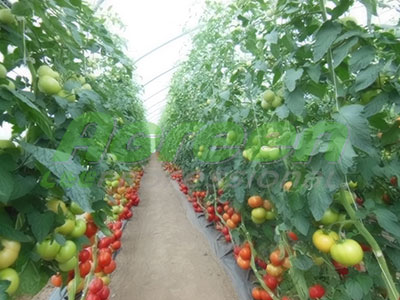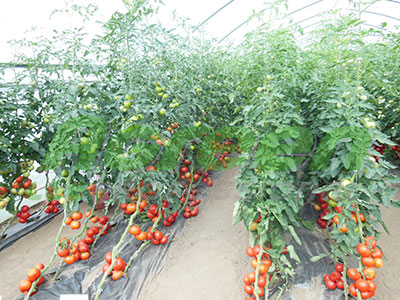Use of Agreen agricultural fiber for cultivating tomatoes
Tomatoes are heat-loving plants, so our climate is
ideal for their cultivation. Every summer resident and farmer wants to get a
harvest as early as possible, so he tries to plant seedlings in early spring.
Agro fiber is used to protect it from frost and bad weather. At the expense of
Agreen agrofiber, you can get products that have a good marketable appearance
and a high yield.
Agreen agrofiber can be used as a covering material,
covering tomatoes from above. And you can lay it on the ground to get rid of weeds
in this way. Black agricultural fiber is suitable for mulching. And for
sheltering tomatoes, it is necessary to use white agricultural fiber, with a
low density.
Tomato cultivation technology
Tomato seeds can be sown
immediately in open ground, but then you will have to wait for seedlings for
quite a long time. In order to speed up this process, you need to grow
seedlings for planting in the ground. Seedlings are usually grown in
greenhouses or glasshouses. The seeds begin to be sown at the end of March, and
after two months the seedlings will be ready for planting in the ground. The
optimal air temperature during sowing is 20-25 °C. When the first shoots
appear, it is recommended to lower the temperature for 5-7 days to 15°С. After
that, the temperature rises again. Such a transition will allow plants to
switch to autotrophic nutrition. When growing seedlings, diving should be
carried out. When diving, seedlings are planted in a larger container or
containers. Before planting in the ground, seedlings have about 10 leaves, and
their height should reach 30 cm.
After the last severe frosts, seedlings are planted.
Be sure to water until the seedlings are accepted. The distance between plants
should be about 50 cm, and between rows - 90 cm. In order to save time, it is
better to plant seedlings in mulched soil. Black agricultural fiber with a
density of 50 g/m2 is suitable for these purposes. Agrofiber should
be laid on the ground, and holes should be made in it for planting tomatoes.
Cuts are made crosswise with a sharp knife. After that, seedlings are planted.
Weeds do not sprout, and you save your time by not spending it on tilling the
soil.
White agrofiber for shelter should have a low density
so as not to damage the tomatoes with its weight. The optimal density for
growing tomatoes is 17-23 g/m2. Some varieties of tomatoes require
special supports or arcs for growing. In this case, the covering agrofiber is
covered over the arcs. If you are growing high varieties of tomatoes and you
need to tie them up constantly, then it is preferable to use agrofiber of
greater density. A white agrofiber with a density of 50 g/m2 is
suitable for creating tunnels. As practice shows, agricultural fiber for
sheltering tomatoes is placed over seedlings very quickly and easily, and after
a couple of weeks you can notice the results of the work done. Tomatoes grow at
a faster rate, and fruits appear earlier than usual.
Light and moisture penetrate well through Agreen
agricultural fiber. Harmful ultraviolet rays do not harm the growth of
tomatoes. Agrofiber protects plants well from frost and bad weather. Hail and
heavy rain will not be able to destroy your harvest. As a rule, agrofiber
begins to be removed after 4-6 weeks, after planting seedlings.
Cultivation of tomatoes requires some effort. It is necessary to pay attention to soil moisture. Watering is necessary for proper and rapid growth of tomatoes, but excessive moisture can harm your plants. Watering can be carried out through the agrofiber without removing it. Under it, moisture is stored longer, and you can water the tomatoes less often. The best option for watering is morning or evening. Drip irrigation is considered the most effective. But installing such a system is not the cheapest option, although it fully justifies the costs. If the weather conditions allow not to water the tomatoes, then you should take advantage of this. A moderate rain will be able to moisten the soil on its own, and you will not need to water the plants once more.



Harvesting
When using Agreen agrofiber,
you will be able to harvest 2-3 weeks earlier than with conventional
cultivation. At the same time, the yield will increase by 25-30%. Tomatoes must
be collected at certain intervals. Since they do not reach immediately. The
ripeness of vegetables is indicated by their color. Green tomatoes should
remain unpicked until fully ripe. If you grew tomatoes for sale, they should be
carefully placed in boxes or packed in special containers.
Due to the fact that the agrofiber has a certain
width, it is easy to remove. If you don't need it, you can fold it and use it
next year. Covering agrofiber with proper use can last up to 6 seasons.
Agrofiber will help protect tomatoes until harvest.
Although agrofiber is made of strong materials, it is advisable to store it in a closed room. Agricultural fiber does not lose its properties during storage. It will also cope well with early frosts, preventing the plants from freezing. Water permeability and light permeability will remain at a high level. Buying agricultural fiber, you will get a high-quality harvest at an early date. Having spent money on the purchase once, you will be able to use agricultural fiber for several seasons and your expenses will quickly pay off. Agrofiber is a universal product. It can be used in any region of Ukraine. In the southern regions, agrofiber will be able to protect plants from harmful ultraviolet rays, and in the western regions - from hail and strong gusts of wind.


